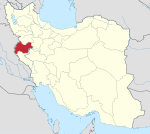Malaverd
 From Wikipedia the free encyclopedia
From Wikipedia the free encyclopedia
Malawerd | |
| Alternative name | Tang-e malaverd |
|---|---|
| Location | Kermanshah Province, Iran |
| Region | Kermanshah |
| Coordinates | 34°24′24.72″N 47°5′30.76″E / 34.4068667°N 47.0918778°E |
| Altitude | 1,460 m (4,790 ft) |
| Type | cave |
| Length | 16m |
| Width | 18m |
| History | |
| Founded | ca. 60,000 BP |
| Abandoned | ca. 2,000 BP |
| Periods | Middle Paleolithic, Upper Paleolithic, Chalcolithic, Iron Age III, Parthian |
| Cultures | Mousterian, Baradostian |
| Associated with | Neanderthal |
| Site notes | |
| Excavation dates | 2012 |
| Archaeologists | Sonia Shidrang |
| Condition | Registerd in the Iran National Heritage List, 12019 |
| Ownership | Ministry of Cultural Heritage, Tourism and Handicrafts, Iran |
Malaverd is an archaeological site in the north of Kermanshah, in Iran. It is located in the Tang-e Malaverd valley, at the western end of Mount Meywala, about 8 km (26,247 ft) from the west of Taq-e Bostan. Malaverd is one of the Paleolithic cave sites in the south of Mount Meywala. This site was recorded during a survey conducted be Fereidoun Biglari in 1999 [1] and registered in the Iran National Heritage List in 2005.[2] The site was excavated by a team of archaeologists under the direction of Sonia Shidrang in August 2012.[3] The site contained a 170 cm thick sequence of archaeological deposits. The excavations revealed that the cave was occupied during the Middle Paleolithic (c. 60,000 to 40,000 years ago), Upper Paleolithic (c. 35,000 to 28,000 years ago), Chalcolithic, Iron Age III, and Parthian. The cave is the first Upper Paleolithic site in the Kermanshah region that was excavated by an Iranian archaeologist and the first dated Upper Paleolithic site in the region.[4] The other important cave site near Malaverd is Do-Ashkaft Cave.
References[edit]
- ^ Biglari, Fereidoun; Heydari, Saman (2001). "Do-Ashkaft: A recently discovered Mousterian cave site in the Kermanshah Plain, Iran" . Antiquity . 75 (289): 487–488. doi : 10.1017/S0003598X00088578 .
- ^ "Archived copy". iranshahrpedia.com. Archived from the original on 6 October 2019. Retrieved 22 February 2022.
{{cite web}}: CS1 maint: archived copy as title (link) - ^ Shidrang, Sonia, Alireza Moradi Bistuni, Marjan Mashkour, 2014, Test excavation in the Paleolithic cave site of Malaverd Cave, Kermanshah, Proceedings of the annual Symposium on Archaeological Research in Iran, pp. 283–281, Iranian Center for Archaeological Research, ICHTO. Tehran. (In Persian with English abstract)
- ^ Azarnoush, M., & Helwing, B. (2005). Recent archaeological research in Iran–prehistory to Iron Age. Archäologische Mitteilungen aus Iran und Turan, 37, 189-246.

